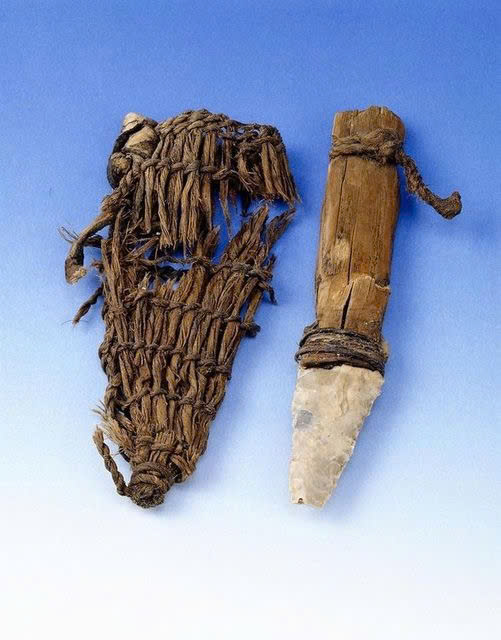In the chronicles of archaeological exploration, few discoveries resonate as profoundly as the dagger found alongside Ötzi the Iceman. This extraordinary artifact, preserved for over five thousand years, offers a rare and vivid glimpse into the resourcefulness and technological ingenuity of our ancient ancestors. Beyond its utility as a survival tool, the dagger serves as a testament to the complexities of prehistoric life and the enduring human spirit of innovation.
When Ötzi’s remarkably preserved body was unearthed in the Alps, archaeologists were astonished by the treasure trove of items accompanying him. Among these, a complete Copper Age dagger stood out as an unparalleled find. This unique weapon, the only fully intact dagger of its kind from this era, provides invaluable insights into the craftsmanship, trade practices, and survival strategies of a time long past. It bridges the gap between history and prehistory, shedding light on a period often shrouded in mystery.

The dagger was accompanied by an intricately designed sheath that speaks volumes about the ingenuity of its maker. Constructed from lime tree bast, the sheath was far more than a mere protective cover for the blade. It featured a cleverly placed leather eyelet, allowing Ötzi to secure the dagger to his clothing or belt for easy access. This ingenious design ensured that such an essential tool was always within arm’s reach, a necessity in the unpredictable and often perilous world of the Copper Age. Interestingly, the sheath was significantly longer than the blade itself, suggesting that the dagger had been continuously reshaped and sharpened throughout its life, gradually reducing its original size.
One of the most remarkable revelations about Ötzi’s dagger lies in the material from which it was crafted. Modern analysis has shown that the flint used to create the blade originated in Trentino, Italy, located hundreds of kilometers from the site where Ötzi’s body was found. This discovery challenges previously held assumptions about the limited mobility of prehistoric societies. It hints at the existence of extensive trade networks or long-distance travel routes, demonstrating that even in the Copper Age, humans were far more interconnected than often imagined.
The dagger also reveals a profound understanding of tool maintenance and resourcefulness. The blade, though small in size—comparable to an arrowhead—was meticulously cared for by Ötzi. Using a specialized tool known as a retoucheur, he regularly resharpened the flint to maintain its functionality, even as the blade’s size diminished over time. This practice underscores the sophisticated knowledge of resource management possessed by prehistoric people. They understood the value of extending the life of their tools through diligent maintenance, a skill essential for survival in an era where resources were both precious and finite.
More than just a cutting tool, the dagger was a multifunctional instrument central to Ötzi’s daily life. Its versatility made it indispensable, serving purposes ranging from hunting and food preparation to basic defense. The fact that it was consistently within reach, thanks to the sheath’s secure design, emphasizes its vital role in Ötzi’s routine. In a harsh and unpredictable environment, the dagger was not merely a tool but a lifeline—a tangible symbol of the ingenuity that defined human survival during this period.
Beyond its practical uses, Ötzi’s dagger provides compelling evidence of a more advanced prehistoric society than previously understood. The sourcing of materials from distant locations suggests the presence of well-established trade routes or shared knowledge among communities separated by vast distances. The craftsmanship displayed in the dagger’s creation—particularly the seamless integration of the flint blade and lime tree bast sheath—reveals a level of specialized skill that was likely passed down through generations. Even the thoughtful choice of materials highlights a deep understanding of the natural world, with each component carefully selected for its functionality and durability.
This ancient tool continues to captivate researchers and enthusiasts alike, offering timeless lessons about human resilience and innovation. It reminds us that the resourcefulness of our ancestors was not merely about survival but about thriving within the constraints of their environment. By maximizing limited resources through clever design and careful maintenance, they laid the foundation for the technological advancements that we enjoy today.
The dagger’s discovery also challenges modern perceptions of prehistoric technological capabilities. It demonstrates that early humans were not only skilled in crafting tools but also adept at adapting them to meet evolving needs. The ability to create, maintain, and innovate with limited resources speaks to a level of sophistication that resonates even in our modern era.
As we continue to study Ötzi’s dagger, its legacy endures as a profound connection to our shared human history. This small yet significant artifact reshapes our understanding of the Copper Age, revealing the complexity and interconnectedness of societies that existed thousands of years ago. It serves as a poignant reminder that even the simplest objects can tell extraordinary stories about human ingenuity, adaptability, and perseverance.
The lessons embedded in this ancient tool extend beyond its historical significance. They invite us to reflect on the qualities that have defined humanity across millennia: creativity, resilience, and the relentless pursuit of improvement. Ötzi’s dagger, with its humble yet powerful presence, is not just a relic of the past—it is a symbol of the enduring spirit of innovation that continues to shape our world.





